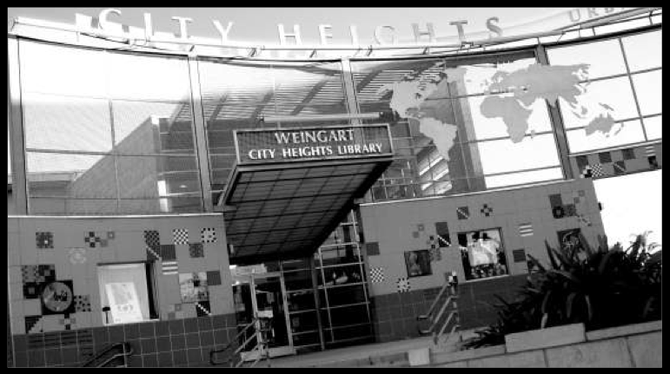 Facebook
Facebook
 X
X
 Instagram
Instagram
 TikTok
TikTok
 Youtube
Youtube

A temple has been erected on the spot where I lived on Central Avenue.
A small band of brown-robed Vietnamese monks purchased the lot from my landlord and turned the old bungalow into a Buddhist prayer hall. It is now a two-tiered pagoda fronted by a large statue of Kwan Yin and four gray pillars topped with lions.
A block and a half away are two Christian churches: King of Kings Temple and Iglesia Monte de Sion. To the north lies Our Lady of Kazan Orthodox Church, and up and around the corner is the multilingual Church of the Nazarene.
This part of town has undergone a lot of development — public and commercial buildings, an "urban village," and a "retail village." But the soul of Mid-City might be better represented by its churches and places of meditation — a good four dozen I found, ranging from stately structures to converted houses and storefronts — ministering to every ethnic community.
The busiest church is probably the miniature Catholic cathedral of Our Lady of the Sacred Heart, since half the residents here are Latino. Besides its stained-glass windows, statues of the saints, and icons of the stations, the church displays an image of Our Lady of Guadalupe and a plaque commemorating the 117 Vietnamese martyrs.
A little east is Fairmount Baptist Church, which shares its home with the First Haitian Christians and its annex with the Iglesia Bautista Evangelica. The congregation at St. Mark's Episcopal prays before a display window to the street. Farther on are the Sudanese Presbyterians and the Medhanialem Ethiopian Church, the latter hosted by Faith Lutheran. You'll find various Apostolics, Assemblies, Pentecostals, Fellowships, Christ Churches and their Hispanic counterparts, along with some unanticipated brethren such as Cambodian Baptists and Vietnamese Methodists and Seventh-Day Adventists. There are three more Eastern Orthodox churches, including San Gabriel Ethiopian. And what neighborhood would be complete without a Kingdom Hall and its nattily dressed Witnesses?
A second Vietnamese Buddhist temple occupies a pair of yellow-and-brown houses in East San Diego, and a Chinese temple overlooks the eastward trend of University Avenue. For Cambodian Buddhists there's the "old temple" (used primarily by the earlier Khmer refugees) and the more ornate "new temple" (whose members speak Khmer, Lao, or Thai).
Atop the patch of hill known as Little Mogadishu, where Somalis, Afghans, and other Muslims have clustered, there are two unassuming mosques, one identifiable by the shoe cubbies outside.
You can hardly walk down a street or turn a corner without running into some religious community. You may be strolling through a quiet residential block or in a retail center when you're suddenly accosted by a pair of bicyclists in shirt and tie asking about your salvation.


A temple has been erected on the spot where I lived on Central Avenue.
A small band of brown-robed Vietnamese monks purchased the lot from my landlord and turned the old bungalow into a Buddhist prayer hall. It is now a two-tiered pagoda fronted by a large statue of Kwan Yin and four gray pillars topped with lions.
A block and a half away are two Christian churches: King of Kings Temple and Iglesia Monte de Sion. To the north lies Our Lady of Kazan Orthodox Church, and up and around the corner is the multilingual Church of the Nazarene.
This part of town has undergone a lot of development — public and commercial buildings, an "urban village," and a "retail village." But the soul of Mid-City might be better represented by its churches and places of meditation — a good four dozen I found, ranging from stately structures to converted houses and storefronts — ministering to every ethnic community.
The busiest church is probably the miniature Catholic cathedral of Our Lady of the Sacred Heart, since half the residents here are Latino. Besides its stained-glass windows, statues of the saints, and icons of the stations, the church displays an image of Our Lady of Guadalupe and a plaque commemorating the 117 Vietnamese martyrs.
A little east is Fairmount Baptist Church, which shares its home with the First Haitian Christians and its annex with the Iglesia Bautista Evangelica. The congregation at St. Mark's Episcopal prays before a display window to the street. Farther on are the Sudanese Presbyterians and the Medhanialem Ethiopian Church, the latter hosted by Faith Lutheran. You'll find various Apostolics, Assemblies, Pentecostals, Fellowships, Christ Churches and their Hispanic counterparts, along with some unanticipated brethren such as Cambodian Baptists and Vietnamese Methodists and Seventh-Day Adventists. There are three more Eastern Orthodox churches, including San Gabriel Ethiopian. And what neighborhood would be complete without a Kingdom Hall and its nattily dressed Witnesses?
A second Vietnamese Buddhist temple occupies a pair of yellow-and-brown houses in East San Diego, and a Chinese temple overlooks the eastward trend of University Avenue. For Cambodian Buddhists there's the "old temple" (used primarily by the earlier Khmer refugees) and the more ornate "new temple" (whose members speak Khmer, Lao, or Thai).
Atop the patch of hill known as Little Mogadishu, where Somalis, Afghans, and other Muslims have clustered, there are two unassuming mosques, one identifiable by the shoe cubbies outside.
You can hardly walk down a street or turn a corner without running into some religious community. You may be strolling through a quiet residential block or in a retail center when you're suddenly accosted by a pair of bicyclists in shirt and tie asking about your salvation.
Comments